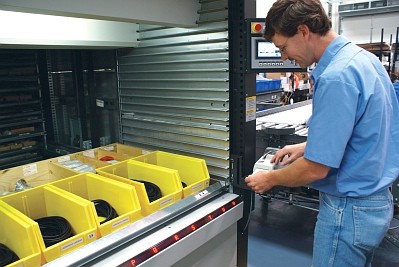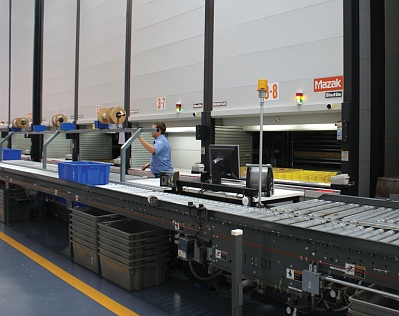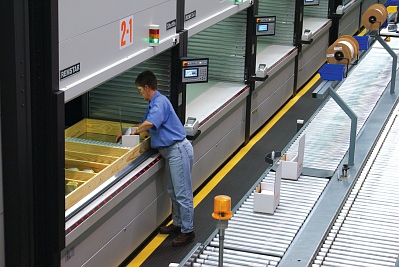
Metal-cutting builder Mazak automates parts centre
December 4, 2009
By Ed Romaine
 More than ever, technology is being called upon to solve manufacturing’s quest for global competitiveness. Competitive manufacturing requires shorter production lead times with less inventory, making equipment utilization more important than ever to the bottom line. With advanced design and technology today’s machines are much more productive, capable of doing the work of three or four machines compared to twenty years ago.
More than ever, technology is being called upon to solve manufacturing’s quest for global competitiveness. Competitive manufacturing requires shorter production lead times with less inventory, making equipment utilization more important than ever to the bottom line. With advanced design and technology today’s machines are much more productive, capable of doing the work of three or four machines compared to twenty years ago.
With the trend toward high productive, multitasking machines quick response with repair parts and on-site service in order to keep machine utilization at a high level have taken on a new level of importance in today’s manufacturing environment. One company that has stepped up to meet this challenge is Mazak Corp., which supports high-technology machines through technical innovation, and its extensive network of worldwide parts and service support. This commitment is clearly evidenced in the company’s newly redesigned North American parts centre located in Florence, Ky. Upgrading to an automated facility, the warehouse’ superior efficiency is based on a state-of-the-art parts storage and retrieval system, designed and built by KardexRemstar, handling 39,000 different part numbers with less labour and unprecedented speed.
Mazak is a large, worldwide metal-cutting builder, with eight manufacturing facilities in Japan, the U.S., the U.K., Singapore and China, along with 30 technology centres worldwide. By producing machines close to its major markets in the world Mazak better understands what its customers need and can develop products to meet their specific requirements.
In 1974, Mazak established U.S. headquarters in Florence, expanding manufacturing operations and offering complete customer support, including customer service, training, unit rebuilding and parts inventory in the U.S. They now have eight North American technology centres including Kentucky, Georgia, Connecticut, Illinois, Texas, California, Canada and Mexico.
Today, Mazak’s 500,000-sq.-ft. Florence facility produces more than 30 different models, at the production rate of 130 machines a month. Its 45,000 -sq.-ft. parts centre maintains an inventory of more than $65 million in parts– ball screws, linear guides, motors, spindles, etc. The warehouse handles parts distribution primarily for the United States, Canada, Mexico and South America and stocks parts for every Mazak CNC sold in the Western Hemisphere.
“Mazak has made a very strong investment into its aftermarket services because we recognize that our equipment is running in many manufacturing facilities on a 24 hour/7 day a week basis,” says Steve Trammel, national parts manager with Mazak. “With lean manufacturing and multitasking so prevalent, it is extremely important that parts be available immediately to support our customers.”
 The Need for Automation
The Need for Automation
Until recently, Mazak’s stockroom consisted of pallet racks and small vertical lift modules (VLMs) that were manually operated. The orders would print out in the stockroom, and workers would use forklifts, skyjacks, ladders and manual VLMs to pick parts. The workers carried the picked orders to the packing areas where they were packed and shipped – 90 percent of them via overnight carriers, and the remaining 10 percent, which were larger items, through contract shipping.
“Nobody orders parts at 8:00 in the morning,” Trammel continues. “Part orders come in the afternoon and then we have to get them out the same day for delivery to our customers. That was becoming a huge challenge for us in how our stockroom was operating. We have to push through 1,000 to 1,200 orders in pretty much a six-hour window, and we were increasingly throwing more and more manpower into it to deal with the situation.”
“We chose to invest in improving our parts centre to maintain customer satisfaction, which is a prime intention for Mazak,” he explains. “This is the kind of progressive investment that we have made to be here for our customers and stock our items for many years to come.”
 Selecting a Solution
Selecting a Solution
Mazak looked at three criteria in the selection process, when looking for a company to automate its parts centre: they wanted to make sure (a) the company selected had the project management capability to handle a large system integration; (b) that the equipment met its criteria from a viewpoint of design, capacity, features, ease of use, flexibility and software; and (c) a strong support structure for parts, service and warranty. That wanted a company that would be there in the future.
“We wanted to select a company that could handle a turnkey project of this size,” Trammel explains. “We were dealing with conveyors, stacker cranes, software, and VLMs. We also needed a company that supported their products the way we support our products, and that’s why we selected KardexRemstar.”
“The key was understanding what they were after and how to deliver that – integrating the Shuttle VLMs with software, with conveyors, stacker cranes and with pick-to-light,” says George Fiorentino, project manager with KardexRemstar. “Mazak wanted to upgrade their system with newer technology and faster equipment, running in an automated environment. Our system knowledge and capabilities along with our hardware provided Mazak the solution they were looking for.”
Newly Automated Parts Centre
Mazak stocks 46,000 part numbers at its Florence parts centre dedicated to aftermarket parts support. Today, the facility is automated, incorporating parts identification with bar coding, pick-to-light, inventory management software, and computerized order monitoring and tracking. Mazak ships between 1,000 and 1,200 orders a day from this facility.
The new system works like this: Once an order is received and processed into Mazak’s order processing system, the order is ready for picking. Each order is assigned to a tote with a fixed license plate, and is placed on a conveyor in the front end of the system. That tote is then routed to one of four pick workstations, each pod is fed by the mainline conveyor with accumulation capability.
When a tote arrives at a workstation, the operator scans it and then scans a light on the batch station to associate the tote with the corresponding light in the software. The operator can scan up to eight totes in a workstation, so that eight orders can be picked simultaneously.
When the operator indicates, the Shuttle VLMs will move to deliver the product to the operator, and a customer specified barcode part label is printed. The lights will light on Shuttle VLMs directing the operator to the location to pick, how many pieces to pick. The operator then picks the product as directed by the Shuttle VLM, attaches the printed barcode label to the product and turns around to place it into the correct tote or order as directed by the lights on the batch station. The operator then picks the next part presented by the Shuttle VLM. This is repeated until the order has all parts required from that zone.
When an order is complete the lights direct the operator to push the tote back onto the conveyor, where it either gets routed to one of three pack lanes, or it goes into another workstation downstream for further fulfillment. Once at the pack stations, sensors on the conveyors rout the tote to the least full lane so as to not back up the orders in the pack line. Shipping information is automatically forwarded to the pack area, as well as to overnight shipping carriers to speed package pick up and delivery. Underneath the conveyor is another conveyor system for empty tote returns, cycling the totes back to the front of the system, making for a very efficient operation.
Transitioning Made Easy
“Mazak made this transformation within the same building without missing a beat, in a way that it could maintain its current operations,” Fiorentino explains. “KardexRemstar understood that Mazak’s customer support was its top priority. So we jointly developed a plan where Mazak would conduct business as usual on its first and second shifts, then on the third shift Mazak brought in a crew to take down a section of the old stockroom and move those parts into a temporary storage area. The inventory location changes were made so that the next morning they would know where all the parts were so they could take its daily part orders. Then KardexRemstar would come in, at night and weekends, to construct the Shuttle VLMs, four units at a time. This cycle was then repeated until all of the Shuttle VLMs were in place.”
The entire transformation took a little less than six months. During the six-month period some 19,000 new part numbers were added.
Vertical Lift Modules – Old and New
The old vertical lift systems used by Mazak were not computer interfaced or computer driven. There were 12 units and they were much smaller than the new units. The operator would use a location guide next to each of the units, and manually type in what tray number they wanted into a keypad. There were no lights or software, and the system was completely manual.
KardexRemstar installed 13 Shuttle VLMs grouped in four pods, in pick-and-pass workstations. Each tray can hold up to 1,100 pounds of parts. The trays themselves are eight feet wide and 34 inches deep. One of the VLMs is a larger and more heavy duty unit, which is designed for much bigger and heavier parts. The 13 VLMs are a combined 125-foot length, with a conveyor line running in front of them.
In Mazak’s prior system, a worker with an order in his hand would have to look at a tray that might have 50 or 60 parts in it, and he had to find that specific part in the tray specified in the order. The new KardexRemstar Shuttle VLMs are equipped with pick-to-light technology. The Transaction Information Center (TIC) is a light bar that runs across the front of the unit and directs the operator to the exact location of the part to pick and displays the quantity to pick as well as the part number.
Tracking Parts… and Orders
When a customer’s order is called in, it is immediately entered into Mazak’s network system which tracks the status of each order as it moves through fulfillment — such as what items have been picked and exactly where the order is in the system. If a customer calls in and wants something added to the order or changed to the order, Mazak’s order entry people can see exactly where that order is in the system and communicate to the stockroom to get those changes made immediately while the customer’s order is fluid in the system.
Software from FastPic Systems, acts as a transaction processor, controlling the operation of the KardexRemstar Shuttle VLMs, supplying operator instruction and printing barcode labels. The FastPic Software is integrated with Mazak’s existing enterprise software system, PRMS, to control inventory and provide a graphical display of the active totes in the system at any time on monitors at critical processing points, such as pick stations and shipping.
Same Space with More Parts
Mazak kept the same footprint in the parts warehouse, but was able to increase its storage capacity within that space by 95 percent, due to the much denser storage capability in the new Shuttle VLMs.
“The larger Shuttle VLMs, with their 1,100-pound tray capacity, what we had considered in the past to be medium-sized parts that we had to keep on pallet rack, are now parts that we could incorporate into the new VLMs,” explains Trammel. “The VLMs have a much denser storage capacity than the pallet racks do. We were able to move some of the medium-sized parts from our other warehouses, and from our pallet racks into these VLMs. This enabled us to automate those parts within our new VLMs, increase our storage capacity.”
The previous VLMs were handling 20,000 individual part numbers. All of those, plus another 19,000 part numbers, for a total of 39,000 parts, are now being handled by the new Shuttle VLMs within the same footprint. With a 95 percent increase in storage density, Mazak has been able to accommodate parts for new machine models without a problem. Another 7,000 oversized part numbers are stored on racking in the warehouse.
Five-Point Accuracy Check System
When an order for a part comes into the warehouse it is critical that it be picked accurately and shipped immediately so that its customer can receive it the next morning, and have the right part to get their machine up and running. To ensure this occurs, Mazak and KardexRemstar have built in a five-point check system: (1) the warehouse ensures that it carries sufficient inventory so that the part will be in stock when the order arrives from a customer; (2) every part is labeled with a barcode for identification; (3) the light strip on each tray displays the stock number and part name of items to be picked for a client order; (4) when the worker puts the item in the tote, the tote itself re-displays a visual, digital message of the pick order; and (5) in the pack area the items to be shipped are checked against the original order for accuracy before it is shipped. This five point check system has improved picking accuracy from 98 percent to 99.67 percent.
Picking More with Fewer People
”We saved significant labour,” Trammel explains. “Previously, we were using nine workers to handle 111 orders per worker, per day. It was all we could do to get our orders out — running to pick the part, picking the part, then taking it over to packing.”
With the KardexRemstar system, the parts are brought to operators who work in stations. This new system is run with five workers instead of nine, each handling 200 orders per day. Orders picked per person per hour has increased by 80 percent — 13.9 picks per labour hour before, and 25 picks per labour hour now.
“The KardexRemstar system also helped us increase our same-day shipping percentage too,” says Trammel. “Prior to this system we were in the 95-plus percent range of shipping same day on our orders. Now we are up to 97.5 percent. Same-day shipping is no longer an issue. That has been a big improvement.”
www.mazakcanada.ca
www.kardexremstar.com
Advertisement
- Quebec manufacturer gets $300,000 for plant, automation investments
- Canada’s investments in education, technology creating jobs